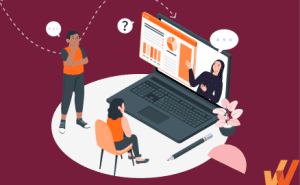New Employee Training: 10 Tips for Effective New Hire Training
- Published:
- Updated: July 16, 2024


As your company grows and onboards critical talent, it’s essential to implement effective employee training programs to enable new hires and reduce their time to proficiency in their new role.
New hire training programs teach new employees about company policies, outline business goals, explain employees’ roles, break down department structures, and build the institutional knowledge foundation your employees need to thrive.
As part of your employee onboarding process, new employee training programs significantly improve the time-to-productivity for new hires to start making impactful contributions quickly. On the other hand, if your initial training programs are disjointed (or nonexistent), new hires will struggle to adapt to their new role, responsibilities, company culture, and policies – ultimately causing employee turnover.
This article explores how organizations can empower new hires with an effective training program that enables them to accomplish their responsibilities and sets them up for long-term success.
What Is a New-Hire Training Plan?
A new-hire training plan is a structured program designed to integrate new employees into an organization effectively. It includes an introduction to the company’s culture, policies, and procedures, as well as job-specific training to equip new hires with the necessary skills and knowledge for their roles.
The plan aims to accelerate the onboarding process, ensuring new employees quickly become productive and confident in their positions. It typically involves a combination of orientation sessions, hands-on training, mentorship, and continuous support to facilitate a smooth transition into the company.
Why Is New-Hire Training Important?
Let’s explore the benefits of new hire training in detail:
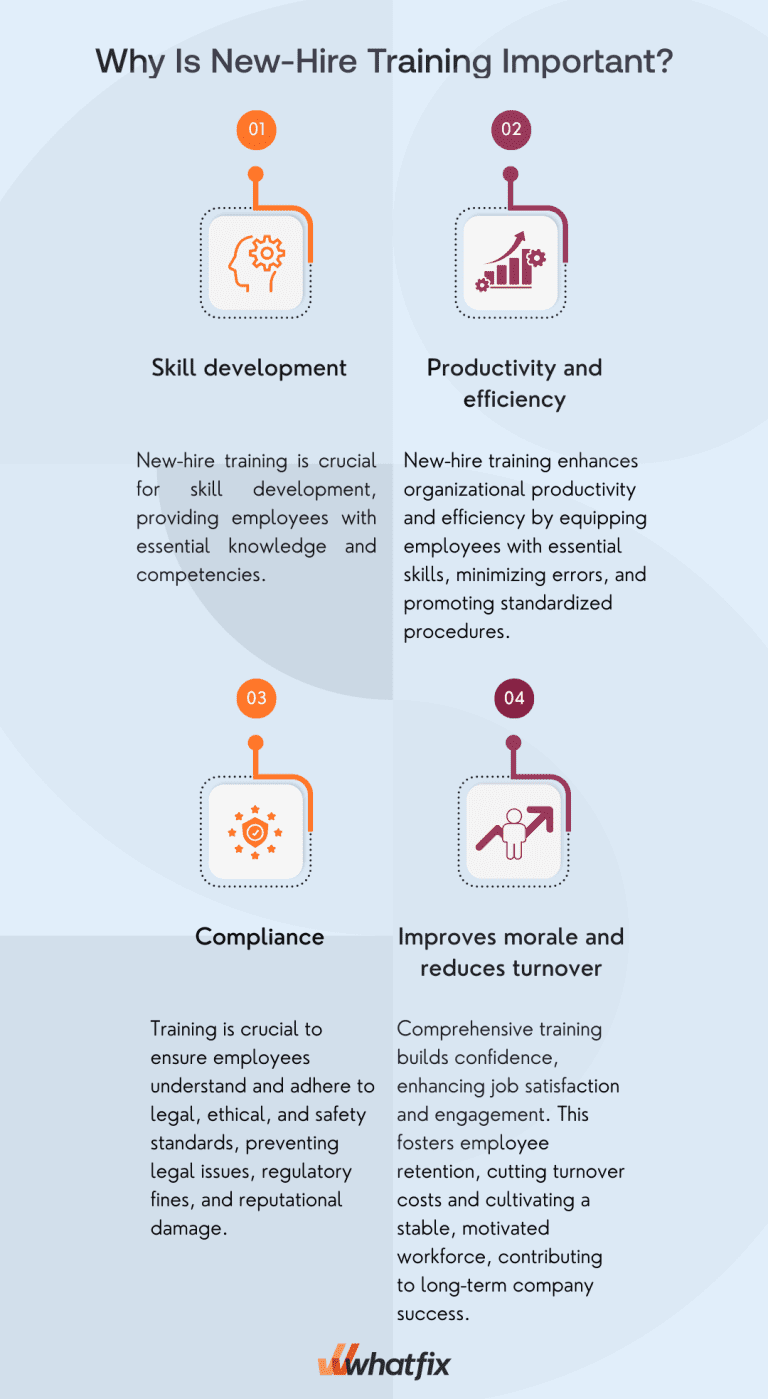
1. Skill development
New-hire training is vital for skill development as it equips employees with the knowledge and competencies necessary to excel in their roles. It helps bridge the gap between theoretical knowledge and practical application, enabling new hires to perform their job effectively from day one, ultimately contributing to the organization’s success.
2. Productivity and efficiency
New-hire training significantly boosts productivity and efficiency within an organization. By providing employees with the skills and information they need, training reduces the learning curve, minimizes errors, and promotes standardized procedures. This leads to quicker task execution, fewer mistakes, and a more streamlined workflow, ultimately enhancing overall productivity and efficiency.
3. Compliance
Training is essential for ensuring that employees are aware of and adhere to legal, ethical, and safety standards. It helps organizations avoid legal issues, regulatory fines, and reputational damage by ensuring that employees are well-versed in industry-specific regulations and company policies, fostering a culture of compliance that is crucial in today’s complex business environment.
4. Improves morale and reduces turnover
New-hire training has a positive impact on employee morale and turnover rates. When employees receive comprehensive training, they gain confidence in their abilities, leading to higher job satisfaction and engagement. This, in turn, promotes employee retention, reducing turnover costs and creating a stable and motivated workforce that contributes to the company’s long-term success.
10 Best Practices for Training New Employees
Here’s how you can develop an effective new-hire training program for your employees.
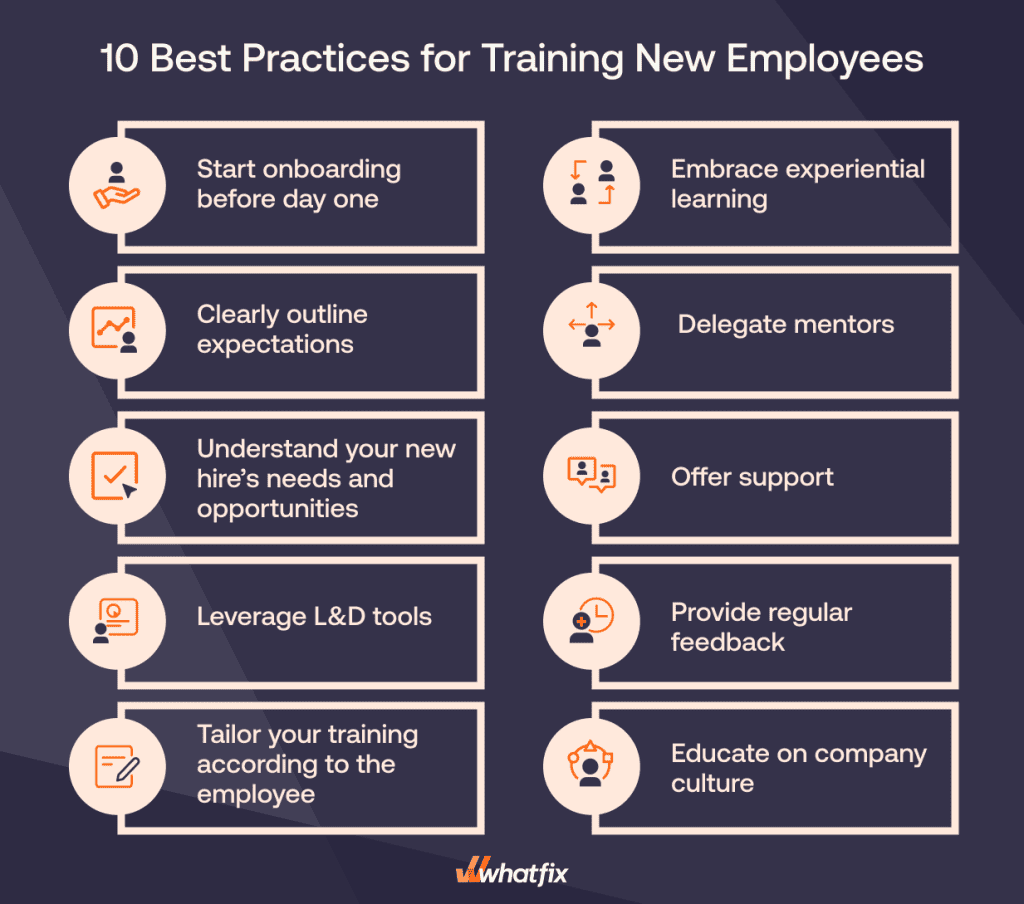
1. Start onboarding before day one
Begin the onboarding process before the new hire’s official start date. This includes sending new hire welcome emails, employment contracts, company policies, and any essential documents they need to complete. Pre-boarding sets a positive tone and ensures that students are well-prepared for their first day.
You can find an example of a new hire email to welcome your rookie team members below:
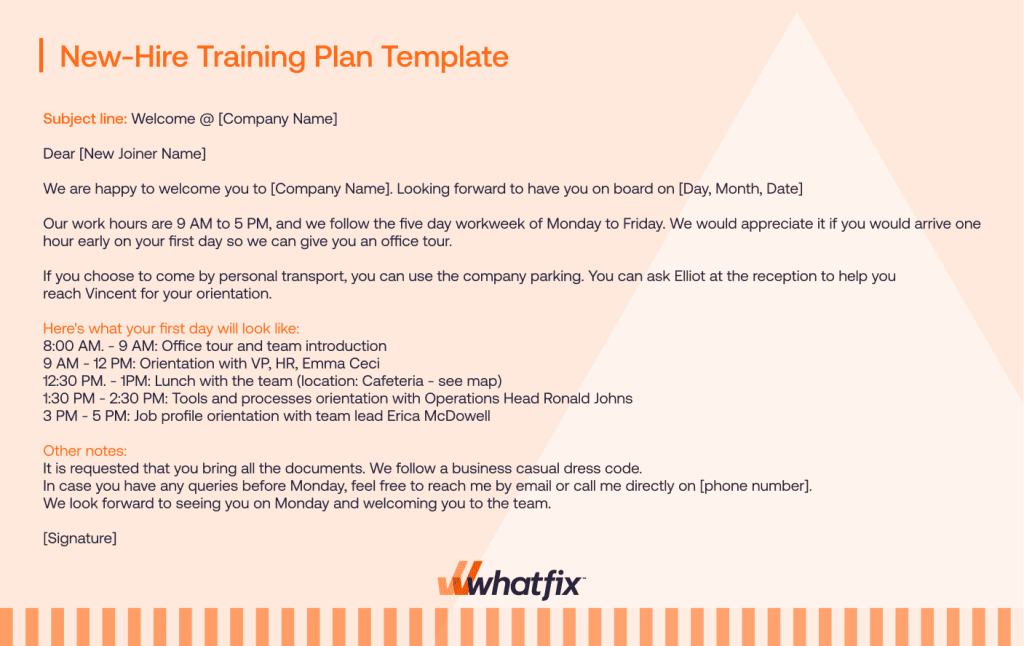
2. Clearly outline expectations
According to BambooHR, 23% of employees quit their jobs because they needed clear guidelines about their responsibilities. In short, they were expected of things that needed to be clearly communicated.
Providing a detailed job description outlining the new hire role’s responsibilities, objectives, and goals is critical. Clear expectations help new hires understand how their role contributes to the organization’s success.
With a 30-60-90 day plan, people managers and hiring leaders can enable new hires with a month-by-month plan to become productive team members by outlining goals for their first 90 days on the job. Here is an example of a 30-60-90 day plan for your new hires:
First 30 Day Goals Listen and learn |
|
60-Day Goals Focus on contribution |
|
90-Day Goals: Mastering their role and driving new value |
|
3. Understand your new hire’s needs and opportunities
Conducting a training needs assessment is critical in developing an effective new-hire training plan. It provides valuable insights into each employee’s knowledge gaps, skills deficiencies, and learning preferences.
This assessment helps tailor the training program to meet individual needs, addressing the exact areas requiring improvement and capitalizing on existing strengths. By understanding these unique requirements, organizations can design a more efficient and focused training plan, leading to faster skill development, increased job satisfaction, and higher productivity among new hires
4. Leverage L&D tools
Leveraging L&D tools for new-hire training offers several advantages. Technology allows for the creating interactive and engaging training material, such as eLearning modules, videos, and virtual simulations, which can cater to various learning styles and preferences.
Software platforms such as learning management systems (LMS) and digital adoption platforms (DAP) enable easy access to training resources, progress tracking, and assessments, streamlining the training process and ensuring consistency.
With Whatfix, enable new employee to “learn by doing” with role-based guidance and support in the flow of work.
Whatfix DAP enables new hires with on-demand, personalized, in-app experiences catering to individual learning styles and paces. It provides real-time guidance and support within the software and systems employees will use, minimizing the learning curve and accelerating proficiency.
Whatfix Mirror enables you to create interactive, replica sandbox environments of any web application for new-hire training without impacting your company data and performance.
5. Tailor your training according to the employee
Any employee, new or tenured, engages the most with a training program when it is most relevant to them, that is, tailored according to their job role. A learner-centric approach is best to ensure each training pathway is relevant to the learner and their goals. This approach helps employees perform better, leading to better business outcomes for the entire enterprise.
Invest in employee training software with algorithms that gather information on your employees and suggest learning activities based on that information. For instance, a digital adoption platform is a team member training solution that integrates with digital tools to provide automated, personalized training in the flow of work.
It incorporates artificial intelligence (AI) that determines a learner’s role in the company, personal development goals, and current training needs to suggest a suitable training module.
A DAP assigns each learner a contextual task list containing relevant walkthroughs based on the learner’s user segment. These walkthroughs show users how to complete an inevitable process by guiding them through each step, showing them relevant training videos, or providing informative articles.
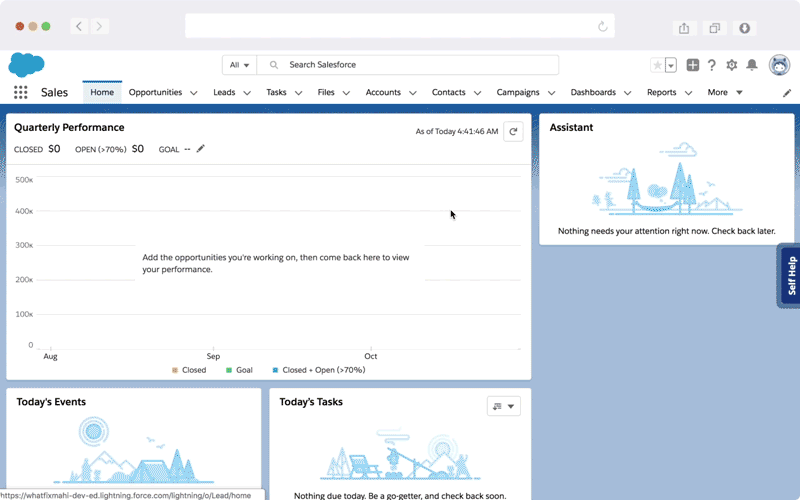
6. Embrace experiential learning
The 70-20-10 model is a well-known L&D framework that states that 70% of learning comes from on-the-job experiences and hands-on learning. This is called experiential learning, which guides employees in performing their daily tasks. This informal, self-directed learning enables employees to learn from their experiences on the job on a daily basis.
This means no expensive and time-consuming classroom training seminars are required outside of employees’ work environment.
For L&D teams looking to structure the 70% of on-the-job learning into actionable employee training and support, implementing a Whatfix digital adoption platform is the best bet.
Whatfix provides L&D teams with a no-code editor to create in-app learning and support that embeds directly into your employees’ workflows and tasks. Whatfix enables employees to maximize their productivity by guiding them through their individual tasks and responsibilities – at critical moments of need. This promotes a “learning by doing” philosophy that L&D teams can structure and implement at scale.
7. Delegate mentors and onboarding buddies
A study found that 86% of new employees with a mentor during the onboarding phase were likelier to stay with their company long-term.
Assigning an onboarding buddy/mentor for your new hires provides them with the comfort of settling well into an unfamiliar environment. An onboarding buddy can offer invaluable insights into the organization’s culture, workflows, and best practices, helping new hires acclimate more quickly and effectively. They serve as a trusted resource for answering questions, offering advice, and sharing practical knowledge, creating a supportive learning environment.
Furthermore, they can help identify areas where individual training needs may arise and provide real-world context to theoretical training, ensuring that new employees understand the company’s processes and navigate them successfully.
Overall, mentorship enhances the onboarding experience, promotes faster integration, and fosters a sense of belonging among new hires, all of which contribute to the overall effectiveness of the training plan.
8. Offer on-demand support
Creating a supportive environment by making resources, help desks, and open communication channels readily available is the most important, yet often overlooked, part of the new employee training process.
Constant performance support enables new hires to ensure that potential obstacles are addressed promptly, reducing frustration and boosting confidence in the learning process. Furthermore, knowing that support is accessible fosters a sense of inclusion and belonging, essential for new employees to thrive, integrate into the company culture, and ultimately succeed within the organization.
Overall, offering support enhances the overall effectiveness of the training plan by minimizing barriers and facilitating a smoother transition for new hires.
9. Provide regular feedback
As new hires become better acquainted with the responsibilities related to their role, it is important for the managers to schedule time with these employees and provide regular feedback. This practice would not only help employees understand what is expected of them, but also help managers understand the challenges employees might be facing and make alternations in the training plan accordingly.
Regular post-training feedback also ensures your new employees are performing their tasks appropriately and are on track to meeting their established goals.
10. Educate on company culture
Education on company culture sets the foundation for alignment and engagement. When new employees understand the company’s values, mission, and vision, they are better equipped to make decisions and take actions that are consistent with the organization’s ethos. It helps new hires integrate into the workplace more seamlessly by providing context for expectations, behaviors, and interpersonal dynamics.
Additionally, a clear understanding of the company’s culture promotes a sense of belonging and shared purpose, which can enhance job satisfaction and employee retention. By incorporating education on company culture into the training plan, organizations ensure that new hires not only acquire the necessary skills but also develop the cultural awareness needed to thrive within the organization, ultimately contributing to its success.
New Employee Training Checklist
Download a free copy of our new employee training checklist to create an effective training program for your new hires.
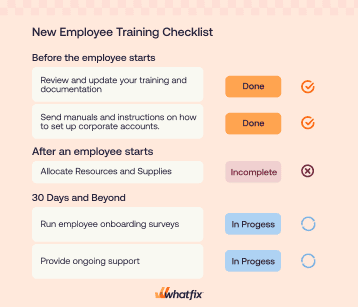
✓ Thank you, the checklist will be sent to your email
What Is the Difference Between Onboarding and Training?
New hire onboarding and training are two different processes that many organizations often use interchangeably. Here are a few differences between the two to give you a clear idea.
Onboarding |
|
Training |
|
Things to Avoid During New Hire Training
Here’s a list of things to avoid while training your new hires.
1. Information overload
It’s crucial to avoid overwhelming new hires with an excessive amount of information during training. Overloading them can lead to confusion and hinder effective learning. Instead, prioritize essential information and deliver it in a structured manner to ensure new employees can absorb and retain key concepts.
2. Ignoring feedback
Neglecting to gather and act upon feedback from new hires is a significant mistake. Failing to address their questions, concerns, or suggestions can lead to frustration and a lack of engagement. Listening to feedback allows organizations to refine their training programs, making them more effective and aligned with employee needs.
3. Failing to nurture their interests
Disregarding the interests and strengths of new hires can hinder their engagement and development. Training programs must be tailored to accommodate varying learning styles and preferences, allowing employees to explore areas that align with their interests. This not only enhances motivation but also helps employees find their niche within the organization.
4. One-way conversations
Engaging new hires in one-way conversations, where they passively receive information without opportunities for questions or discussions, is counterproductive. Interactive training sessions that encourage active participation, questions, and open dialogue foster a deeper understanding and engagement, creating a more dynamic and effective learning environment.
Accelerate new employee training and reduce time-to-proficiency with the Whatfix digital adoption platform
The Whatfix digital adoption platform accelerates new employee training and reduces time to proficiency by providing a user-friendly and interactive learning experience. Through its in-app step-by-step guidance and real-time support, Whatfix ensures that new hires can quickly navigate and master complex software applications and workflows. It offers personalized training modules that cater to individual learning styles and preferences, allowing employees to learn at their own pace.
Moreover, the platform continuously assesses user progress and identifies areas where additional training or support may be needed, allowing organizations to tailor training plans precisely to meet employees’ needs, resulting in faster skill acquisition and greater productivity.
To learn more about Whatfix employee training solutions, click here to schedule a free demo with us!
New Employee Training FAQs
How long should new employee training last?
New employee training typically lasts from a few weeks to several months, depending on the complexity of the job and the industry. Initial training might cover basic orientation and job-specific skills, while continuous training ensures ongoing development and proficiency.
What are some common mistakes to avoid during new employee training?
Common mistakes include overwhelming new hires with too much information at once, failing to provide clear expectations, neglecting ongoing support, using a one-size-fits-all approach, and not incorporating interactive or hands-on learning experiences.
When should new employee training begin?
New employee training should begin as soon as the new hire accepts the job offer. Pre-boarding activities, such as sending welcome materials and setting up initial meetings, can start before the first day. Formal training should commence on the first day of employment.
How to ensure new employees retain what they learn during training?
To ensure learning retention, use reinforcement techniques such as spaced repetition, interactive and hands-on activities, quizzes, and real-world practice. Providing accessible resources and continuous support also helps reinforce learning.
How to measure the effectiveness of new employee training?
Measure effectiveness through feedback surveys, assessments, and job performance monitoring. Track key performance indicators (KPIs) related to the training objectives and conduct regular check-ins and reviews with new employees to gauge progress and satisfaction.
Request a demo to see how Whatfix empowers organizations to improve end-user adoption and provide on-demand customer support
